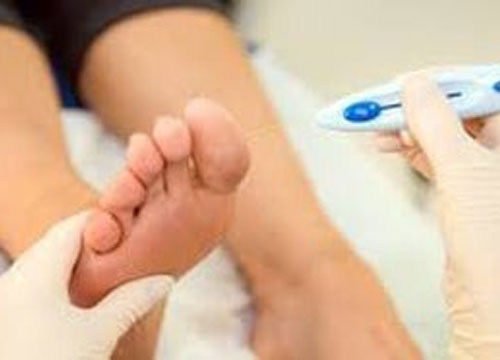Join The Nantwich Clinic Club to keep up to date with news and offers!
Sign Up
Having diabetes means you’re at much greater risk of developing foot problems.
This is because raised blood glucose, also known as blood sugar, can damage the sensation in your feet. It can also affect your circulation, which can lead to you getting less blood supply to your feet.
High blood sugar can cause diabetic neuropathy (nerve damage), which damages the nerves that send signals from your hands and feet. Diabetic neuropathy feels like numbness or tingling in your fingers, toes, hands, and feet. Another symptom is a burning, sharp, or aching pain.
Nerve damage from diabetes can’t be reversed. This is because the body can’t naturally repair nerve tissues that have been damaged.
When you lack sensation in your feet it is important not to walk around barefoot and to check socks, tights and shoes for anything that may cause irritation to the skin, such as a rubbing seam or a tiny piece of grit in your shoe.
Infact, as a Diabetic, it is a good idea to get into the habit of checking for these things even if you are without neuropathy. Once you’re in the habit, should you develop neuropathy, you will already be in a great position to care for yourself.
Ordinarily, these small irritations would be felt and removed. However, as neuropathy prevents any feeling, the smallest of irritations can rub without being felt, and overtime cause inflammation, cuts and sores.
These sores, left untreated, can lead to ulceration.
So, what is a foot ulcer?
A foot ulcer is an open sore on the foot.
A foot ulcer can be a shallow red crater that involves only the surface skin. A foot ulcer also can be very deep. A deep foot ulcer may be a crater that extends through the full thickness of the skin. It may involve tendons, bones and other deep structures.
People with diabetes or poor circulation are more likely to develop foot ulcers which can be difficult to heal.
In people with these conditions, even a small foot ulcer can become infected if it does not heal quickly.
An untreated infection in an ulcer can develop into:
The NHS aim to give every Diabetic an annual foot health check which should involve examining for infection, injury, and bone abnormalities, nerve damage and poor circulation.
As a Diabetic it’s really important to look after your feet – make sure you get your feet checked regularly.
Whether it’s a quick question that you need to ask, or you would like to book an appointment with us, we want to hear from you. Simply click the button below to get started or contact us on 01270 627118.
